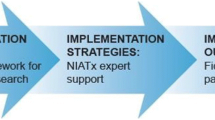Abstract
Substance abuse treatment clients present with an array of service needs in various life domains. Ideal models of addiction treatment incorporate provision or linkages to services to meet clients’ multiple needs; in turn, these wraparound and supportive services are associated with improvements in client retention and treatment outcomes. Using data from large samples of specialty addiction treatment providers in the public and private sectors, this article examines the extent and organizational correlates of the comprehensiveness of service delivery. Multivariate models indicate that private sector treatment facilities offer more “core” medical and treatment services, whereas public sector programs offer more wraparound and supportive services. However, both sectors fall short of the ideal model of service comprehensiveness in terms of absolute number of services offered. These findings raise concerns regarding the quality and availability of needed services for treatment of addiction.
Similar content being viewed by others
References
McLellan AT, Arndt IO, Metzger DS, et al. The effects of psychosocial services in substance abuse treatment. JAMA: The journal of the American Medical Association. 1993;269:1953–1959.
McLellan AT, Grisson GR, Brill P, et al. Private substance abuse treatments: are some programs more effective than others? Journal of Substance Abuse Treatment. 1993;10:243–254.
McLellan AT, Hagan TA, Levine M, et al. Supplemental social services improve outcomes in public addiction treatment. Addiction. 1998;93:1489–1499.
Mojtabai R. Perceived benefit of substance abuse treatments. Psychiatric Services. 2003;54:780.
McLellan AT, Alterman AI, Metzger DS, et al. Similarity of outcome predictors across opiate, cocaine, and alcohol treatments: the role of treatment services. Journal of Counseling and Clinical Psychology. 1994;62:1141–1158.
Joe GW, Simpson DD, Hubbard RL. Treatment predictors of tenure in methadone maintenance. Journal of Substance Abuse. 1991;3:73–84.
Friedmann PD, D’Aunno TA, Jin L, Alexander JA. Medical and psychosocial services in drug abuse treatment: do stronger linkages promote client utilization? Health Services Research. 2000;35:443–465.
Friedmann PD, Lemon S, Stein MD. Transportation and retention in outpatient drug abuse treatment programs. Journal of Substance Abuse Treatment. 2001;21:97–103.
Marsh JC, D’Aunno TA, Smith BD. Increasing access and providing social services to improve drug abuse treatment for women with children. Addiction. 2000;95:1237–1247.
Smith BD, Marsh JC. Client-service matching in substance abuse treatment for women with children. Journal of Substance Abuse Treatment. 2002;22:161–168.
Etheridge RM, Hubbard R. Conceptualizing and assessing treatment structure and process in community-based drug dependency treatment programs. Substance Use & Misuse. 2000;35:1757–1795.
NIDA. Principles of Drug Abuse Treatment: A Research-Based Guide. NIH Publication No. 00-4180. Rockville, MD: NIDA; 2000.
Asche SE, Harrison PA. The relationship between problem severity and ancillary treatment services: is substance abuse treatment responsive to client need? Journal of Behavioral Health Services & Research. 2002;29:345–356.
Etheridge RM, Craddock SG, Dunteman GH, Hubbard R. Client services in two national studies of community-based drug treatment programs. Journal of Substance Abuse. 1995;7:9–26.
Pringle JL, Emptage NP, Hubbard RL. Unmet needs for comprehensive services in outpatient addiction treatment. Journal of Substance Abuse Treatment. 2006;30:183–189.
Durkin EM. An organizational analysis of psychosocial and medical services in drug abuse treatment programs. Social Service Review. 2002;76:406–429.
Friedmann PD, Alexander JA, D’Aunno TA. Organizational correlates of access to primary care and mental health services in drug abuse treatment units. Journal of Substance Abuse Treatment. 1999;16:71–80.
Friedmann PD, Lemon S, Durkin E, D’Aunno TA. Trends in comprehensive service availability in outpatient drug abuse treatment. Journal of Substance Abuse Treatment. 2003;24:81–88.
Lee MT, Reif S, Ritter GA, et al. Access to services in the substance abuse treatment system: variations by facility characteristics. Recent Developments in Alcohol. 2001;15:137–156.
D’Aunno TA, Sutton RI, Price RH. Isomorphism and external support in conflicting institutional environments: a study of drug abuse treatment units. Academy of Management Journal. 1991;34:636–661.
D’Aunno TA, Vaughn TE. Variations in methadone treatment practices: results from a national study. JAMA: The journal of the American Medical Association. 1992;267:253–258.
D’Aunno TA, Vaughn TE. An organizational analysis of service patterns in outpatient drug abuse treatment units. Journal of Substance Abuse. 1995;7:27–42
Fletcher BW, Tims FM, Brown BS. The Drug Abuse Treatment Outcome Study (DATOS): treatment evaluation research in the United States. Psychology of Addictive Behaviors. 1997;11:216–229.
Ducharme LJ, Knudsen HK, Roman PM. Evidence-based treatment for opiate-dependent clients: availability, variation, and organizational correlates. American Journal on Drug & Alcohol Abuse. 2006;32:569–576.
Ball JC, Corty E, Petroski SP, Bond H, Tommasello A. Medical services provided to 2,394 patients at methadone maintenance programs in three states. Journal of Substance Abuse Treatment. 1986;3:203–209.
SAMHSA. National Survey of Substance Abuse Treatment Services 2002: Data on Substance Abuse Treatment Facilities. DHHS Pub No. (SMA) 03-3777. Rockville, MD: SAMHSA; 2003.
Wheeler JR, Fadel H, D’Aunno TA. Ownership and performance in outpatient substance abuse treatment centers. American Journal of Public Health. 1992;82:711–718.
Mee-Lee D, Gartner L, Miller M, Shulman GR, Wilford BB. Patient Placement Criteria for the Treatment of Substance-Related Disorders. 2nd Ed. Chevy Chase, MD: ASAM; 1996.
Knudsen HK, Roman PM. Modeling the use of innovations in private treatment organizations: the role of absorptive capacity. Journal of Substance Abuse Treatment. 2004;26:353–361.
Grella CE, Polinsky ML, Hser Y, et al. Characteristics of women-only and mixed-gender drug abuse treatment programs. Journal of Substance Abuse Treatment. 1999;17:37–44.
Tinney SM, Oser CB, Johnson JA, Roman PM. Predominantly female caseloads: identifying organizational correlates in private substance abuse treatment centers. Journal of Behavioral Health Services & Research. 2004;31:403–417.
Acknowledgments
This manuscript was developed with funding support from the Robert Wood Johnson Foundation (grant no. 53400). Data collection for these analyses was supported by the NIDA (research grants R01DA13110 and R01DA14482). The opinions expressed are those of the authors and do not reflect the official position of either funding agency.
Author information
Authors and Affiliations
Corresponding author
Rights and permissions
About this article
Cite this article
Ducharme, L.J., Mello, H.L., Roman, P.M. et al. Service Delivery in Substance Abuse Treatment: Reexamining “Comprehensive” Care. J Behav Health Serv Res 34, 121–136 (2007). https://doi.org/10.1007/s11414-007-9061-7
Received:
Accepted:
Published:
Issue Date:
DOI: https://doi.org/10.1007/s11414-007-9061-7




